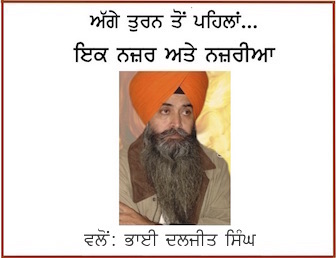Articles/Opinion
‘Sant Rampal’: Farmer’s Son Challenges Hegemony of Arya Samaj, A RSS Ally In Haryana [OP-ED.]
November 22, 2014 | By Jaspal Singh Sidhu
The arrest of former public servant -turned-godman 63-year-old Rampal from his Barwala (Hissar) ashram seems to have ended the two-week long much publicized drama enacted by the Haryana police, but it has, rather, widened social and religious gulf among the people of the area . The police operation took life of five women and a child, injuring of many others including two dozen media persons covering the event. Technically, Rampal’s arrest was sought by the Punjab and Haryana high court in a case of ‘criminal contempt of court’ following his persistent in refusal to appear before the court.
The Barwala event signals much more than what one gathers from the media. Rampal’s abortive defiance appears to be (consciously or unconsciously) challenging the hegemony of the Sangh Privar ideology based on Aryans and non- Aryans divide which uses the Vedic literature as manifestation of the Aryan race. The media story, invariably, only covers the present happenings. And, it is meant for the consumption of general public only interested in the day-to-day developments. For obvious reasons, such reporting suits both the government of the day and the media outlets. By and large, the media (newspapers and TV channels) reels out largely that information (official version) which police and official machinery serves them with punctuation of a little-bit material on the root cause of the controversy which has climaxed to the dramatic custody of Rampal by the police.
!['Sant' Rampal [File Photo]](https://sikhsiyasat.net/wp-content/uploads/2014/11/Rampal-Haryana-e1416654389400.jpg)
‘Sant’ Rampal [File Photo]
The Barwala development has at least a century and half (150 years-old) old history behind it. The resurgence of Arya Samaj in erstwhile Punjab, of which Haryana was a part, took on all shades of monotheistic religious practices. Swami Dayananda Saraswati , the founder of the Arya Samaj ,came on the Punjab scene in 1870s and became the strong critic of “ heterodox” religious schools like Jainism, Buddhism and Sikhism. He detested “religious impurities”, he claimed to have found in above mentioned religions and also abhorred the ‘local languages’ in which these religions were expressed. Dayananda, a staunch votary of Vedas, was of the view that Sanskrit was the only language that could become the vehicle of spiritual, philosophical and lofty ideas.
Swami Dayananda published his book, ‘Satyarth Prakash’ ( Light of Truth) in 1875 and attacked Guru Nanak whom he addressed as ‘dhurta’, meaning rogue and charlatan. He called the Sikh holy book as ‘mithya’ ( false) and the Sikhism as ‘jaal’ (a snare, a trap). This led to a clash between the Sikhs and followers of Arya Samaj belonging to upper Hindu castes and a elite business and educated section having base in Lahore and Amritsar. That confrontation between the Sikhs and the Punjabi Hindu carrying Arya Samaj religious trappings has been continuing till today with periodic manifestations in various forms of clashes over a century including that of latest Punjab problem and the Sikh pogrom of 1984 in independent India.
The holy Sikh scripture includes more than a hundred hymns of Bhagat Kabir, besides carrying the latter’s broad religious concepts as ‘naam’, ‘the creator and unfathomable’ as opposed to Vedanta and Vaisnavism with all its adjutants like asceticism, caste-system and withdrawal from the life.
During his visit to Punjab, Swami Dayananda in 1877-78, initiated ‘Shuddhi’ campaign meaning ‘purification movement’ to reclaim Christian converts from the Sikhs back to the Hindu fold. Later, his successors began the direct conversion from the poor Sikhs at public ceremonies and sowed the seeds of permanent tensions in Hindu-Sikh relations.
Reverently his disciples call him ‘Sant Rampal’ who, too, seemed to have raked up that old historical religious -cultural conflict by challenging the hegemony of Arya Samaj, now a close ally of RSS that commands over the state power, directly in Haryana through BJP chief minister Mohan Lal Khattar . Mr Khattar, is a Hindu Punjabi whose family had migrated in 1947 to Haryana from the core area of Arya Samaj now in Pakistan’s Punjab. Of late, Arya Samaj, particularly after 1947 Parition, virtually merged into the Sangh Privar expressing itself through the RSS ideology.
As per the prevailing religious ethos in the area, Rampal was an ardent devotee of Lord Hanuman and Lord Krishna for 25 years. However, his meditating for hours and following religious practices, Rampal could not attain spiritual peace he was hankering for. This former junior engineer with Haryana’s irrigation department came in contact with Swami Ramdev Anand, a follower of Saint Kabir, a 13th century Saint, hailing from the low caste and who had preached strict monotheism.
Born in 1951 in a typical rural family at Dhanana village in Sonepat , Rampal views underwent a radical change as Anand influenced him greatly. Eventually, Rampal was led to his taking ‘naam’. In 1994, he was ordered by Ramdev Anand to initiate other people into taking ‘naam’, and he quit his government job in 1995.
His journey as a bona fide ‘godman’ began on a four-acre plot at Karontha village, 15 km from Rohtak which still bears a palpable influence of Aray Samaj .
Naturally, as the ‘Kabirpanth’ began sprouting in that area, Rampal’s ashram came into direct confrontation with Arya Samaj . In a violent clash that ensued between his and Arya Samaj followers a 20-year-old Sonu was killed. And he was implicated into that murder case which witnessed him behind the bars for 18 months. Those murder charges are still sticking to his person. Meantime, the followers of his ‘Kabirpanth’ and Arya Samaj have had engaged in several clashes after the 2006 murder resulting in unbridgeable social and religious divide in the area.
Rampal is family man with two sons and two daughters—all married off. His profile on his official website — jagatgururampalji.org— says he grew popular after touring Haryana as a ‘bhajan singer’, and then drew on his following within the Kabir sect to graduate to his own ‘Satlok Ashram’ (name of his religious centre) in 1999.
Rampal’s direct clash with Arya Samaj came up as he had begun criticizing their set- beliefs. He questioned and challenged the origin and ancestry of gods (devi-devtas) and the popular interpretations of Hindu scriptures.
At his congregations, Rampal has been using aggressive language claiming that “real truth” has been hidden from the people by gurus and intellectuals who have interpreted scriptures in the past. He has been drawing people from the lower middle-class as well as those who have been persecuted within popular religions including dalits and anti-Jaat castes backward castes.
“Our race is living being, mankind is our religion, Hindu, Muslim, Sikh, Christian, there is no separate religion,” he says on website.
Arya Samaj followers– believing in the traditional Vedic philosophy which Rampal challenges– were the first to object to him in 2006 when he raised questions over ‘Satyarth Prakash’.
Commenting on ‘Satyarth Prakash’ Rampal says it is not “Light of Truth’ but a book of ‘mithya’ or myths and should be called ‘ Mithyarth Prakash’.
A clash between Arya Samaj followers and Rampal’s devotees in July 2006 at the Karontha ashram saw the arrest of Rampal along with 38 of his followers on murder charges and was released on bail in 2008.
Rampal remained undeterred thereafter as he went on to set up another ‘dera’ (ashram) in Barwala, Hisar.
Today, ‘Satlok Ashram’ has 71 acres of land in Karontha and his rise has been fuelled by generous donations. Rampal also draws his followers from Punjab, UP and far away places of Madhya Pradesh.
The Haryana police used all those tactics on Rampal’s followers what Punjab police had used to raid religious places in Punjab like cutting of power and water supply and blocking the food supplies along with forcing the thinly clad poor devotees to leave the ashram. Some of the followers were even dragged to bus stands and nearby railway stations forcing them to leave the area.
Such developments, as eminent historian Romila Thapar maintains, question the stereotypes and the political narrative raised from nationalistic perspective that “Indian society has always been unchanging society, based on caste structure, —alternatively, it was an idyllic society characterized with harmony and absence of social tensions”. end
Jaspal Singh Sidhu, retired as special correspendent with UNI, New Delhi and has been writing on political,social matters since then. He could be reached at – [email protected]
To Get Sikh Siyasat News Alerts via WhatsApp:
(1) Save Our WhatsApp Number 0091-855-606-7689 to your phone contacts; and
(2) Send us Your Name via WhatsApp. Click Here to Send WhatsApp Message Now.
Sikh Siyasat is on Telegram Now. Subscribe to our Telegram Channel
Related Topics: Jaspal Singh Sidhu




